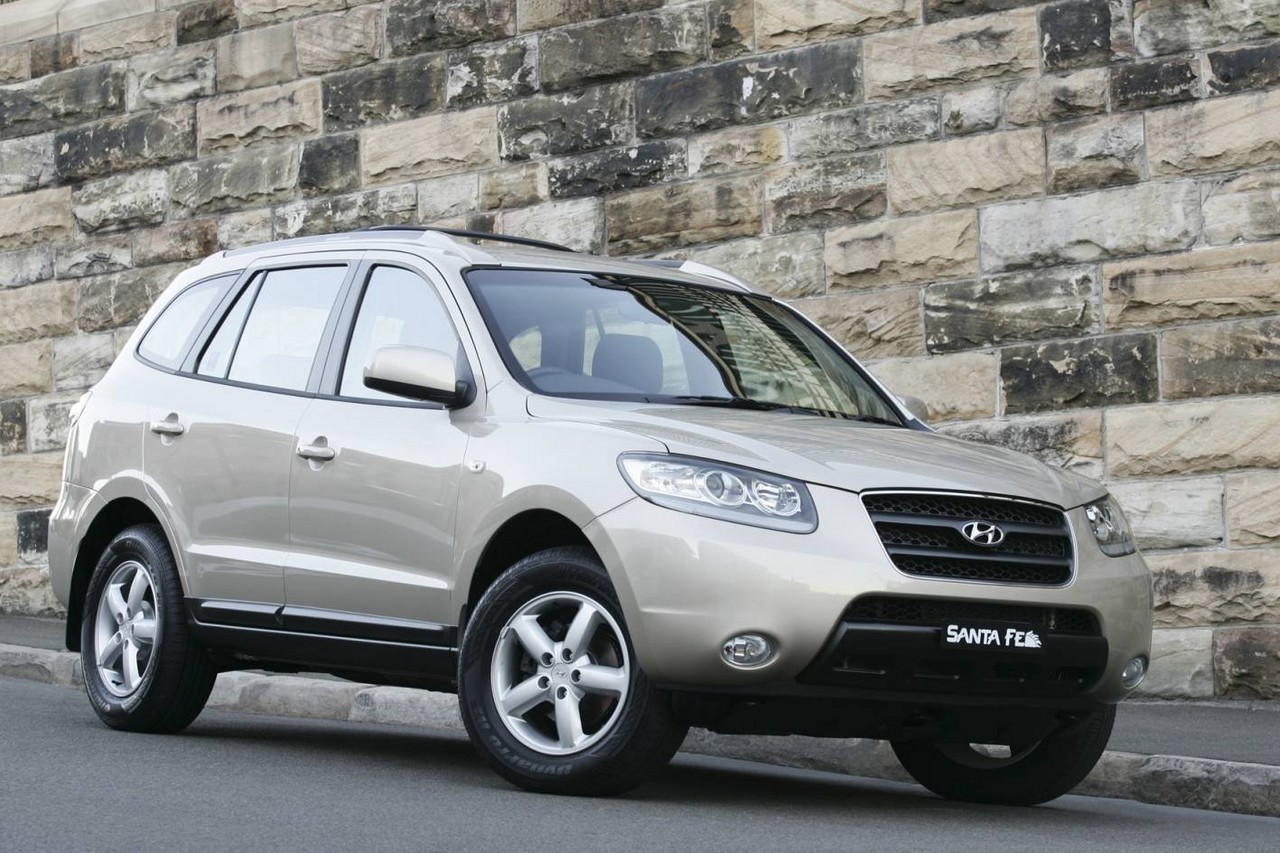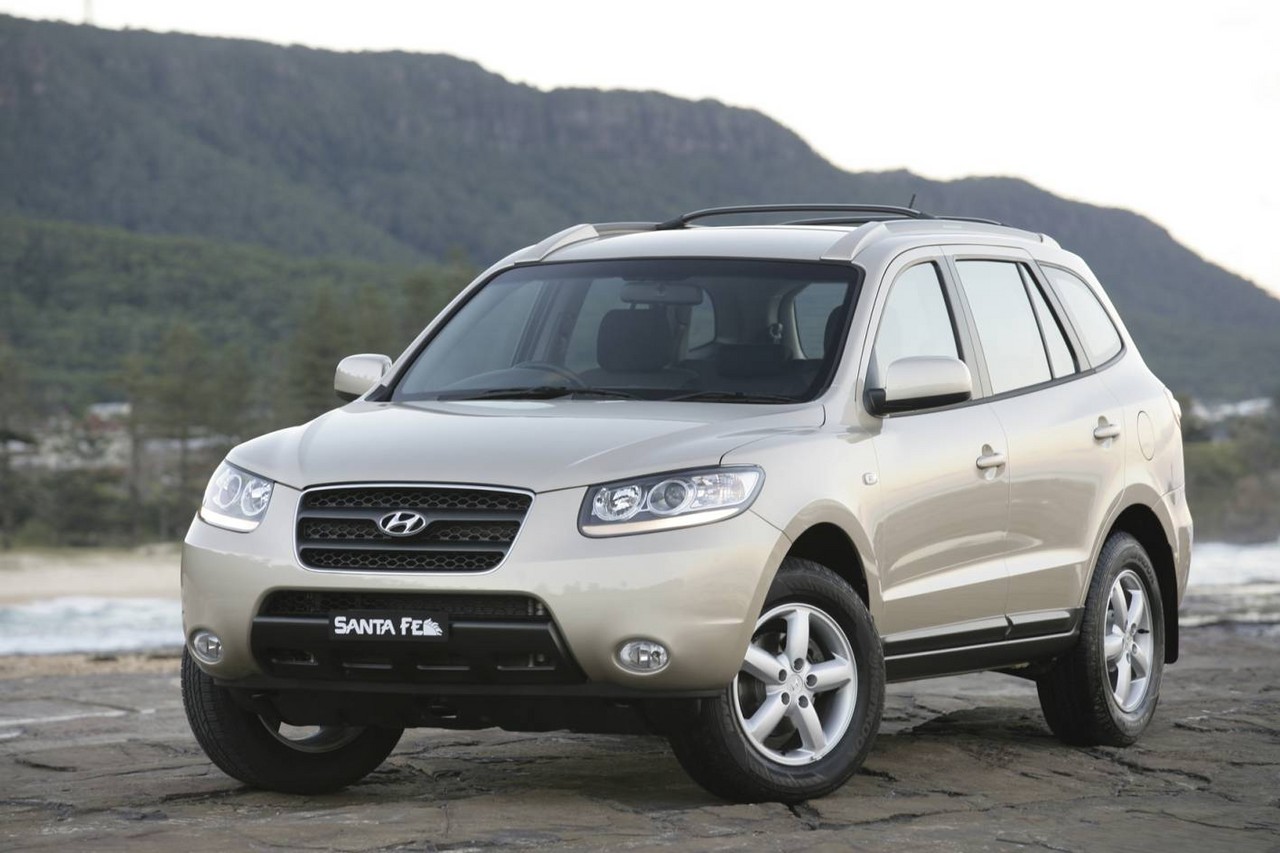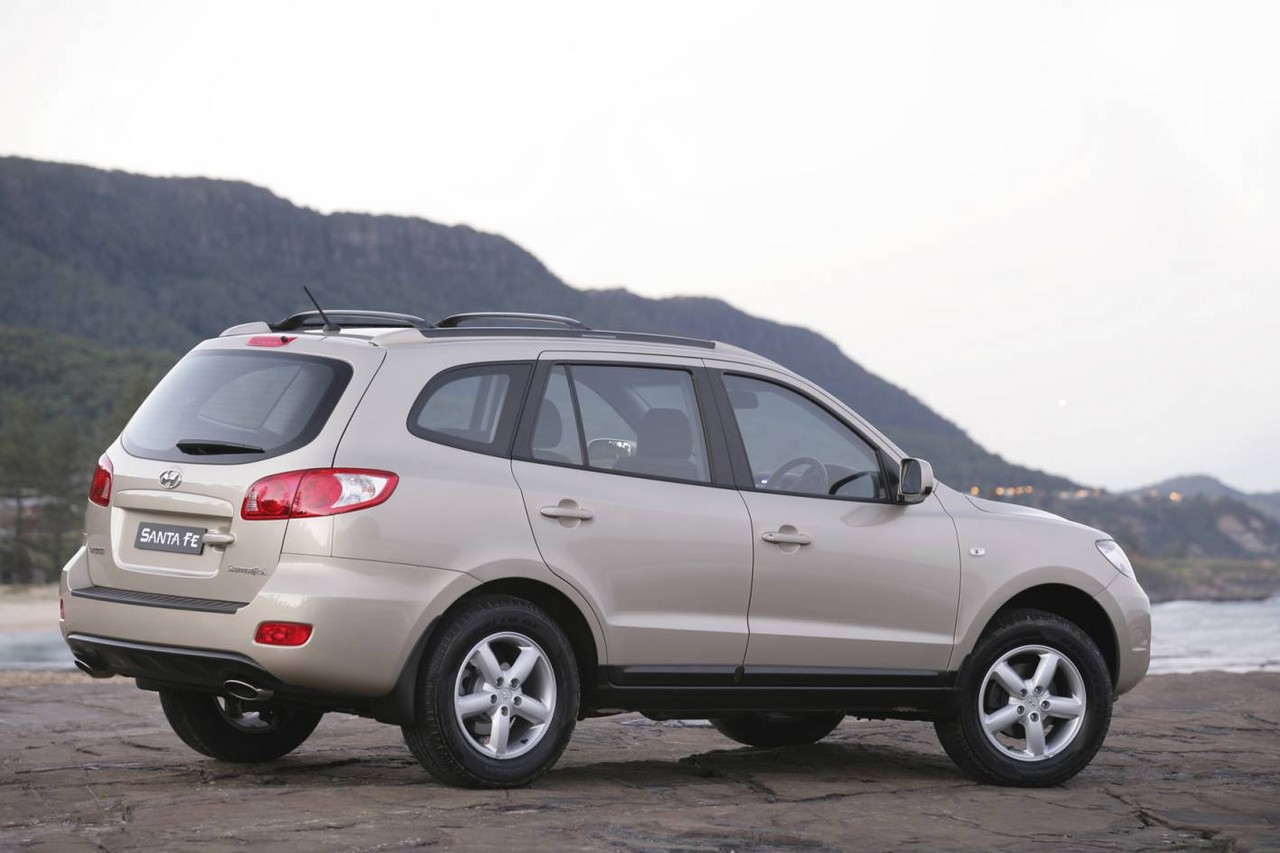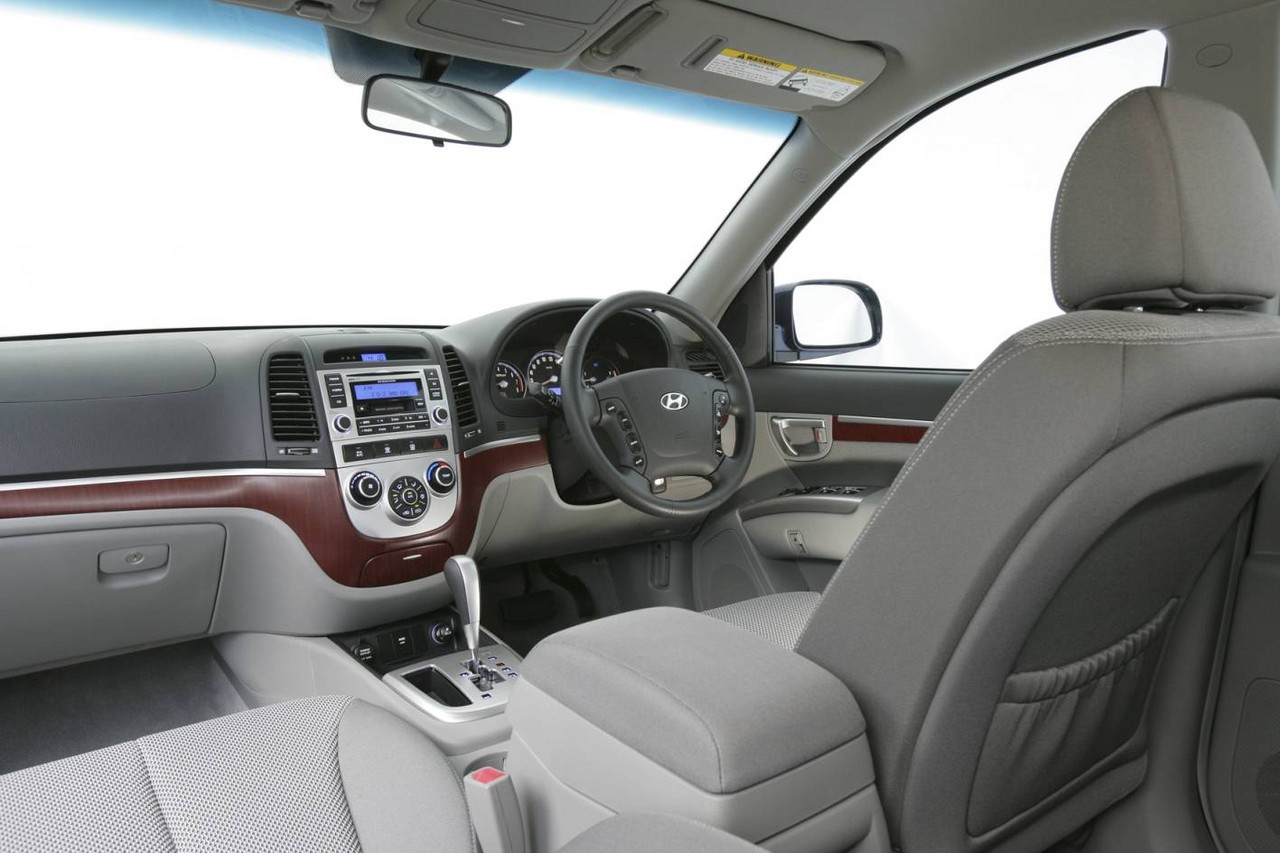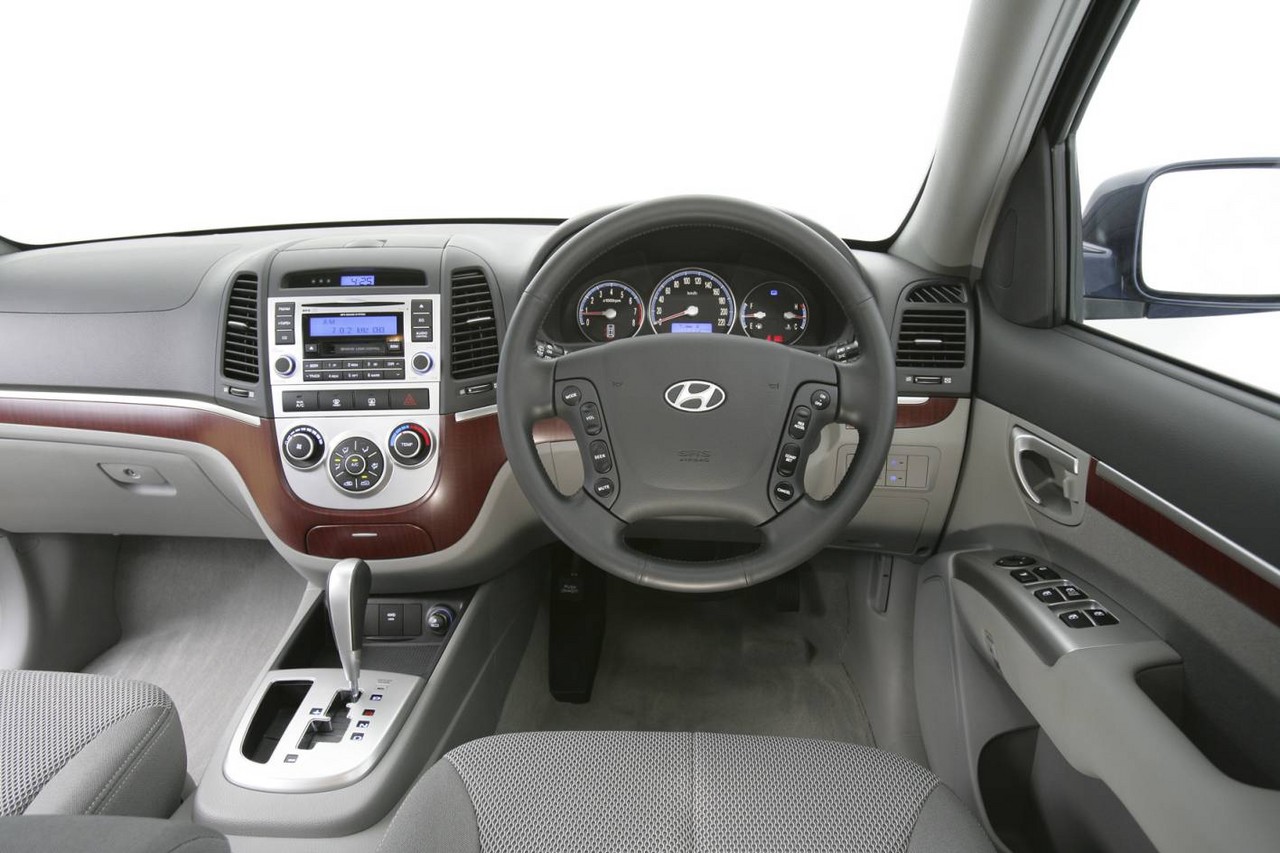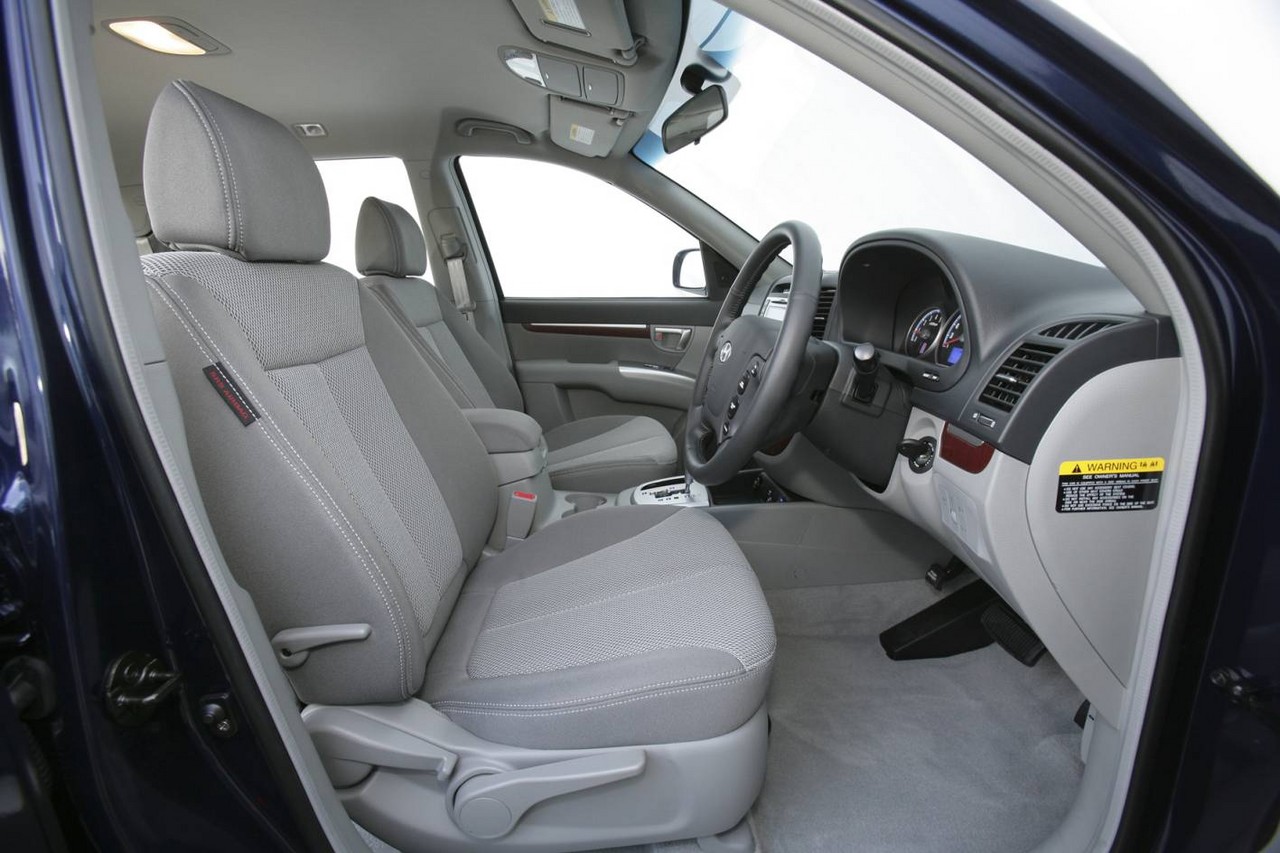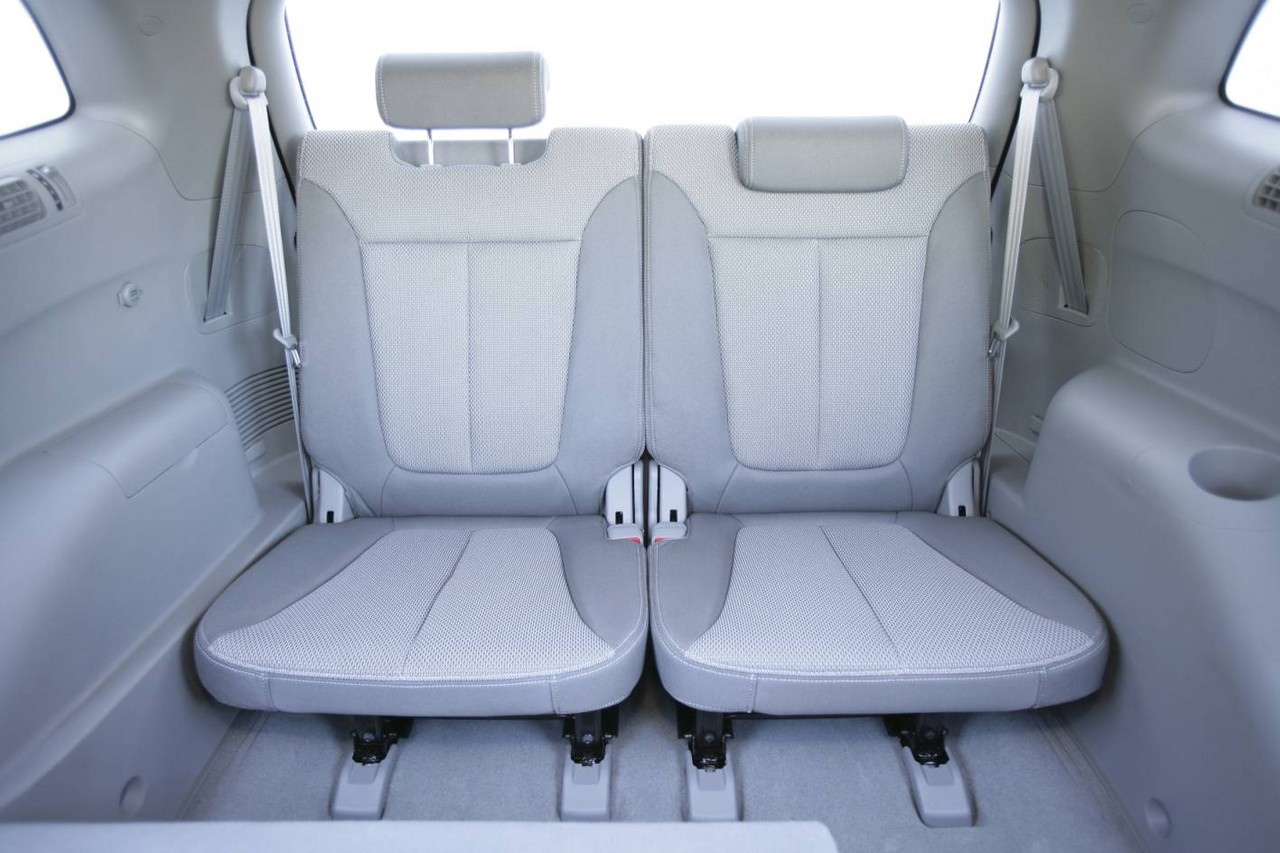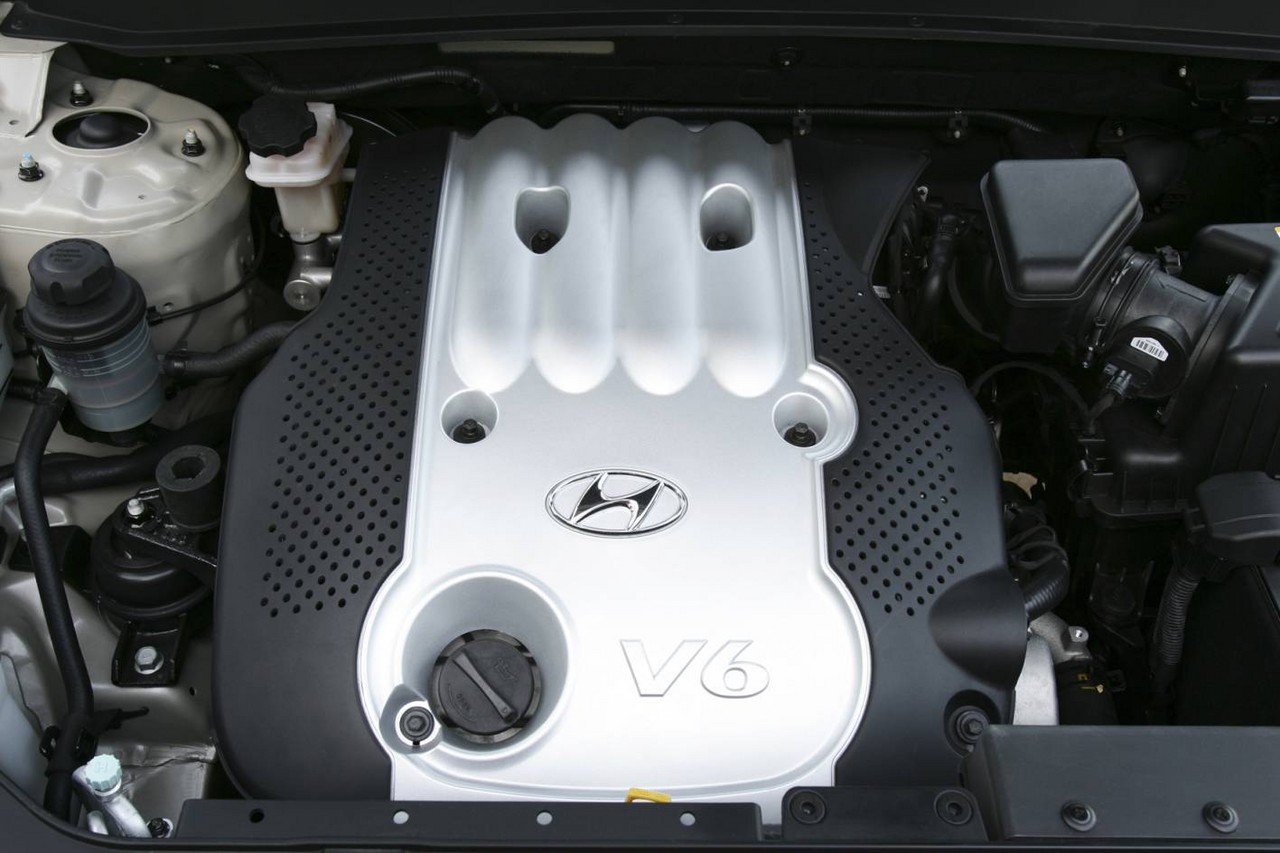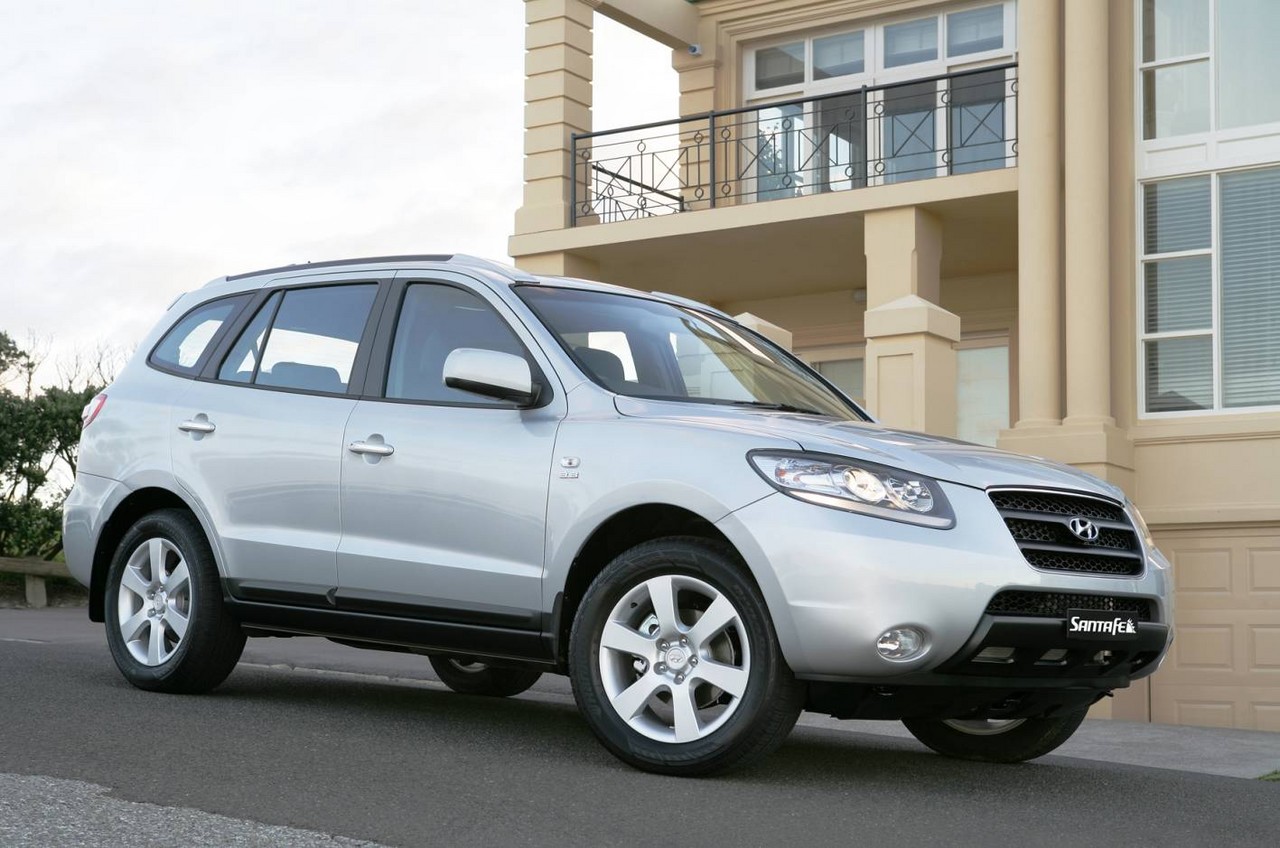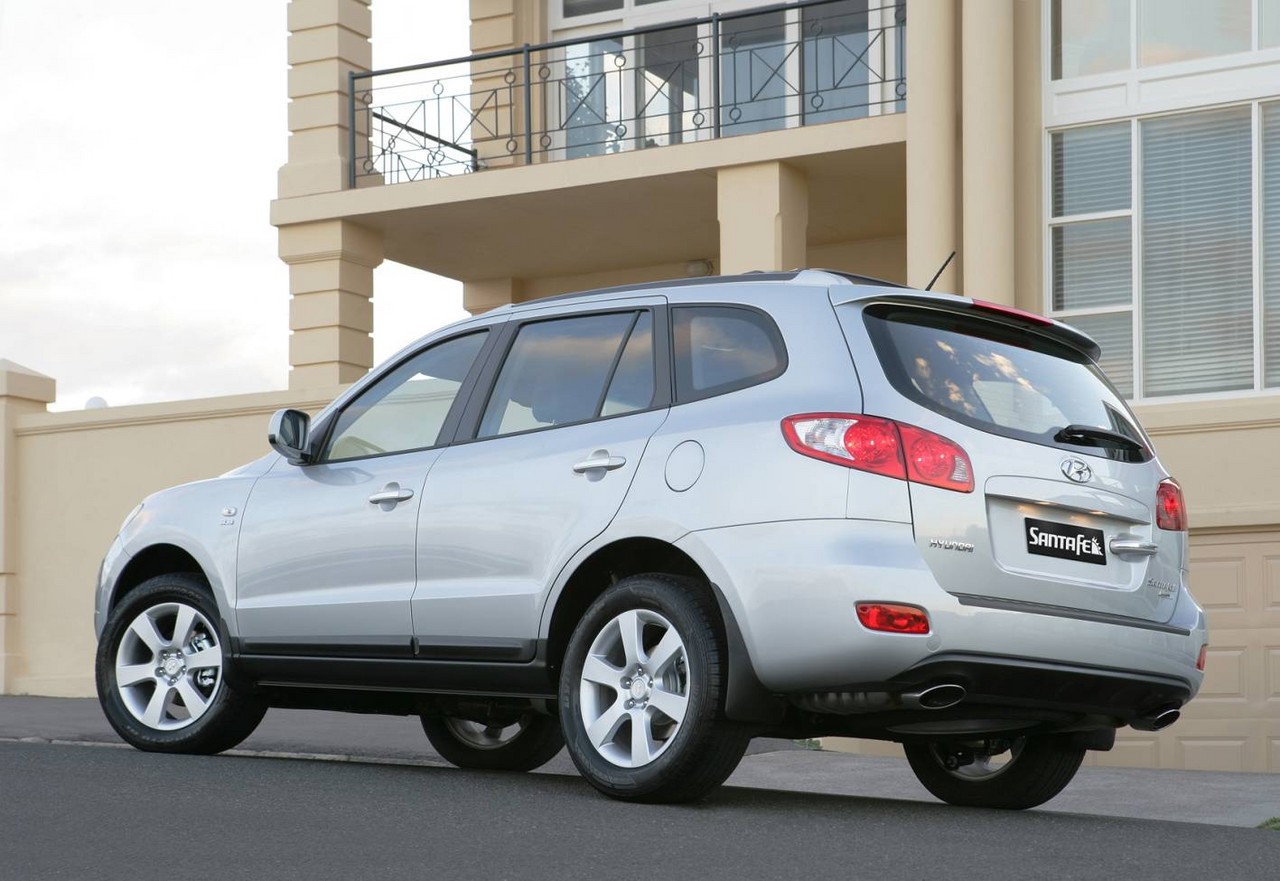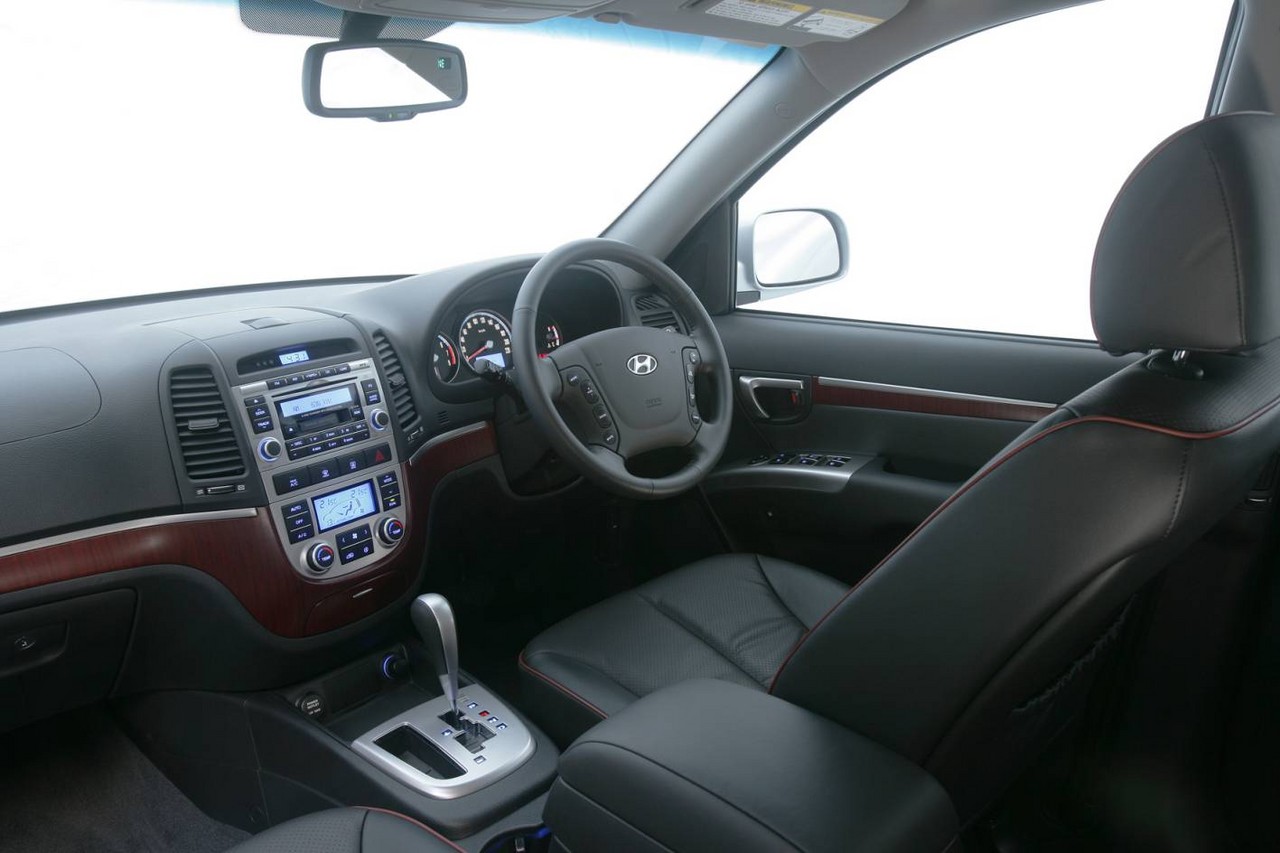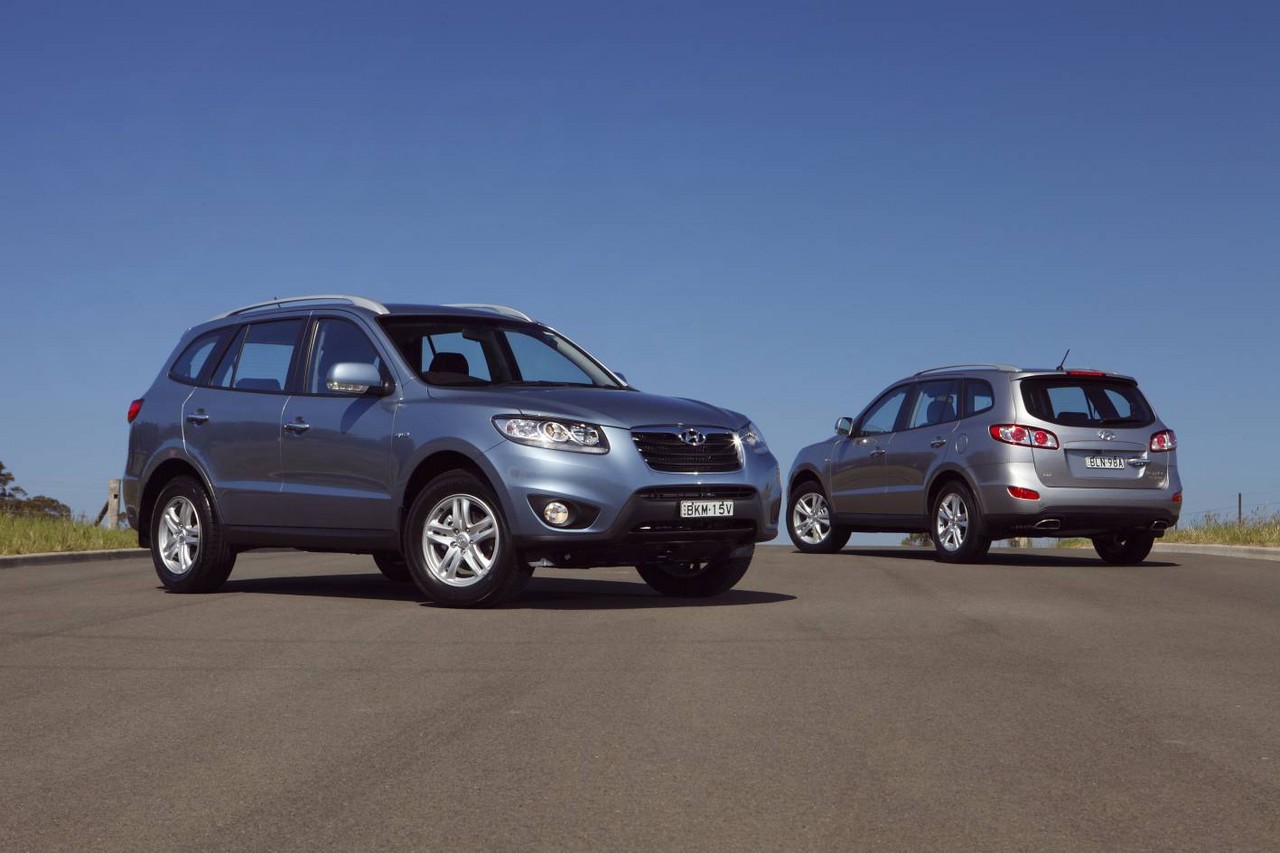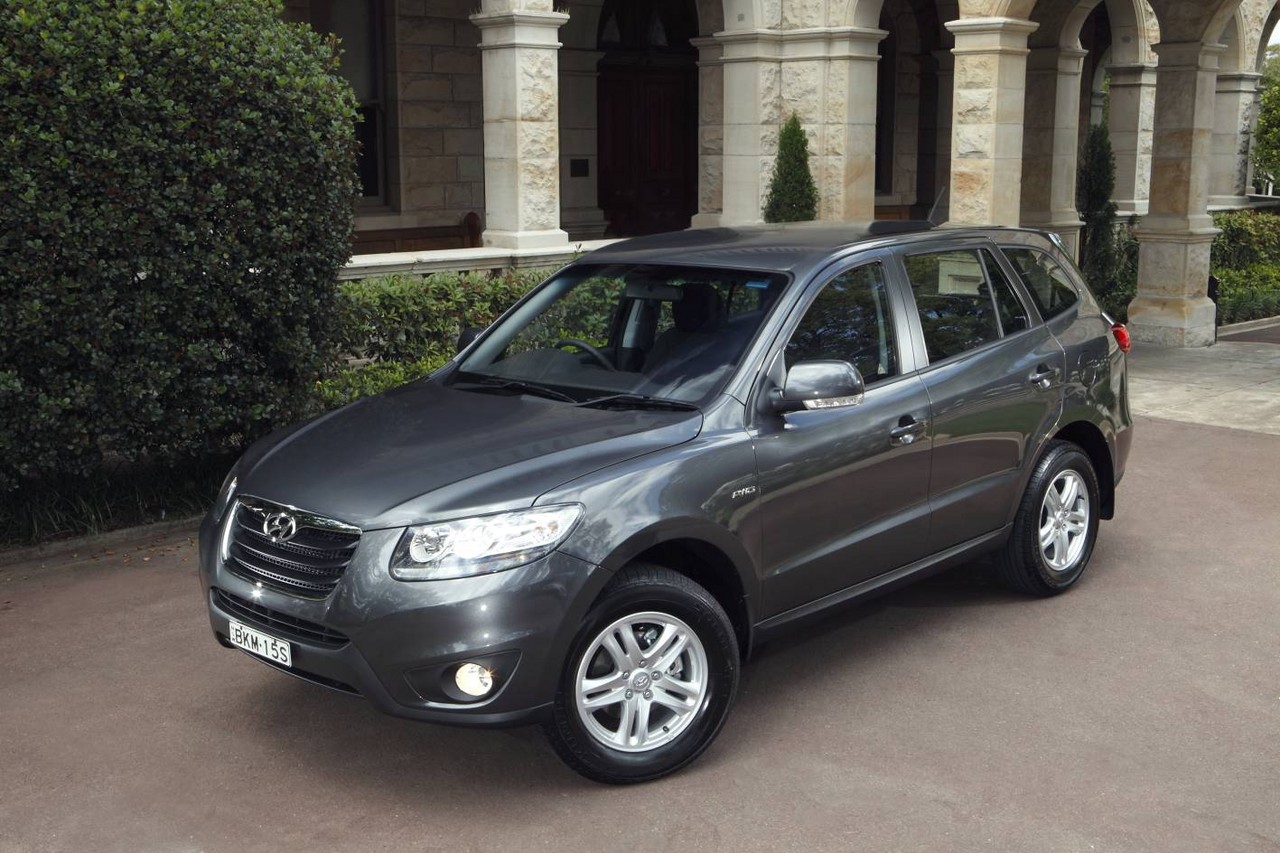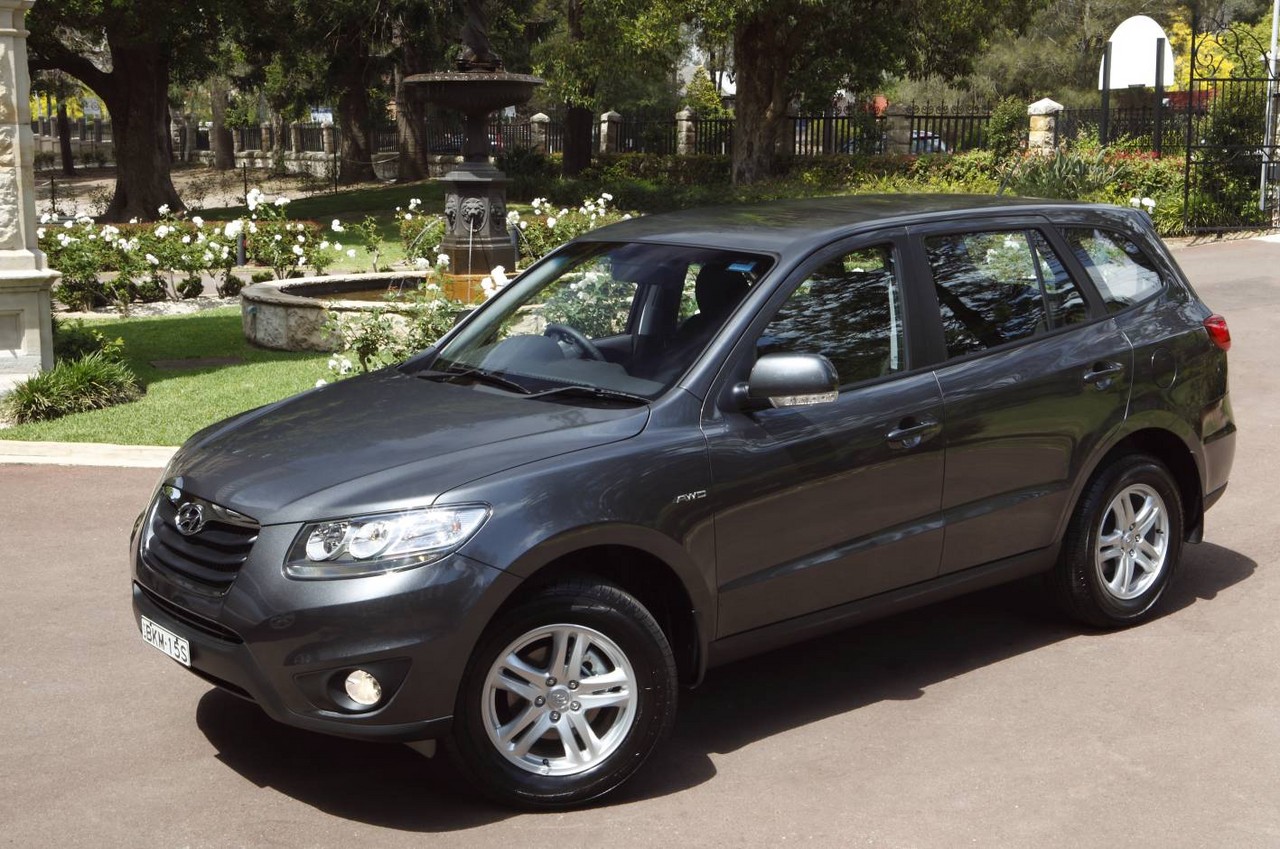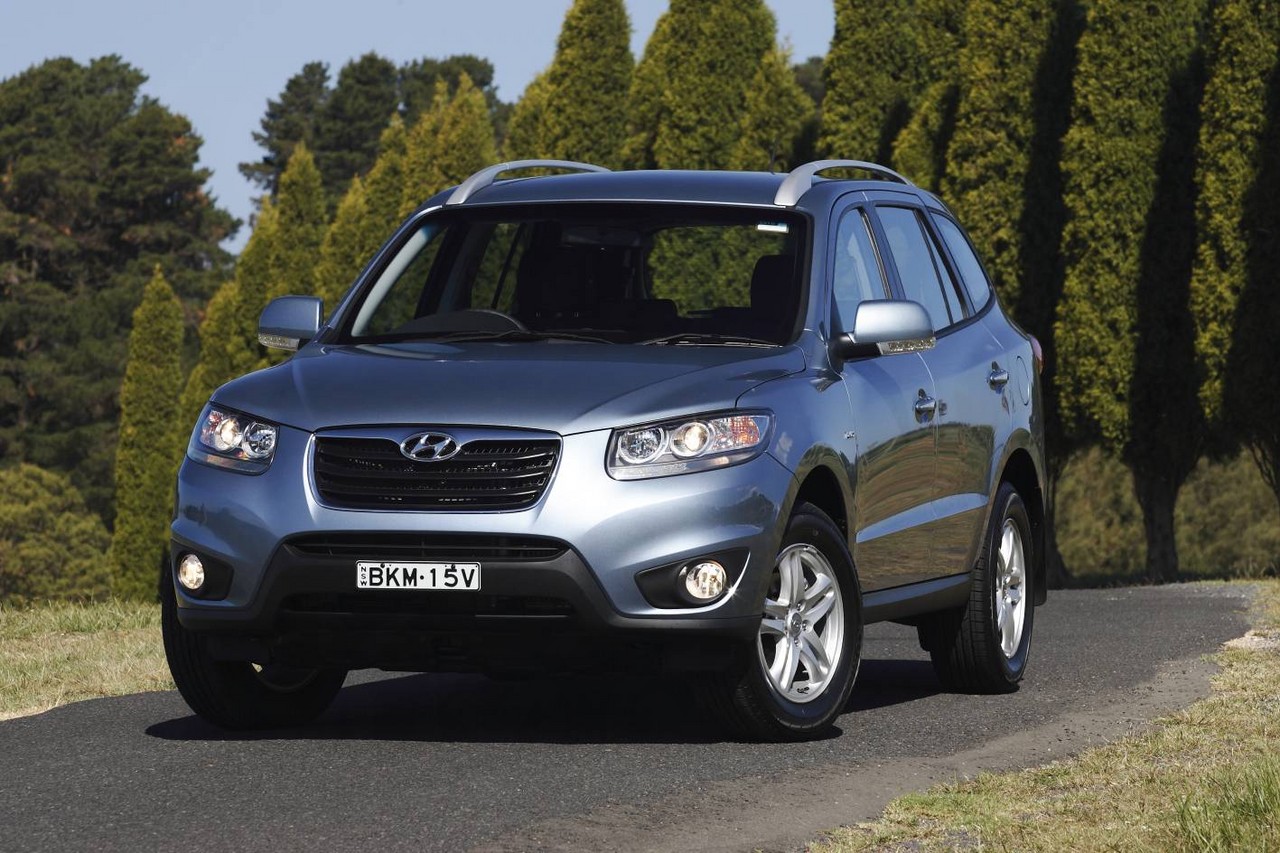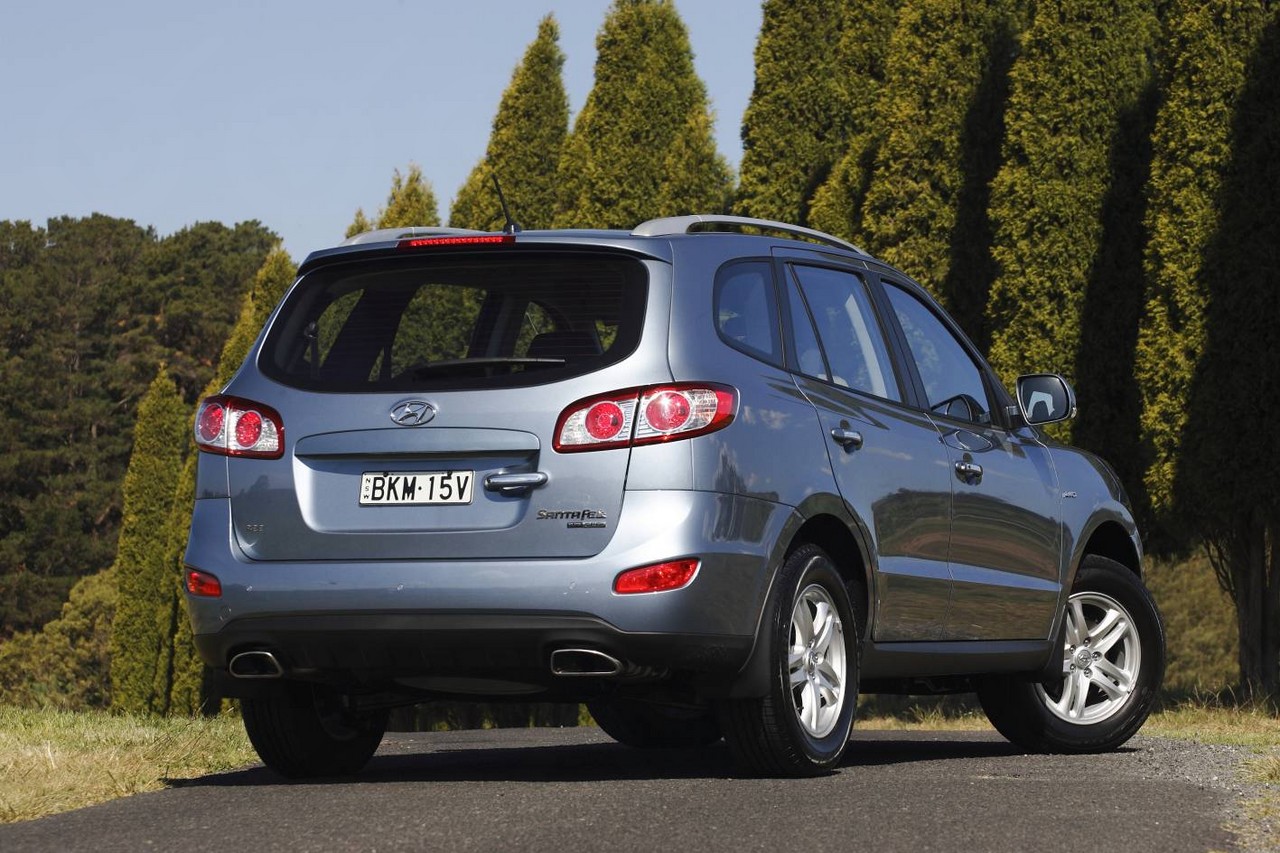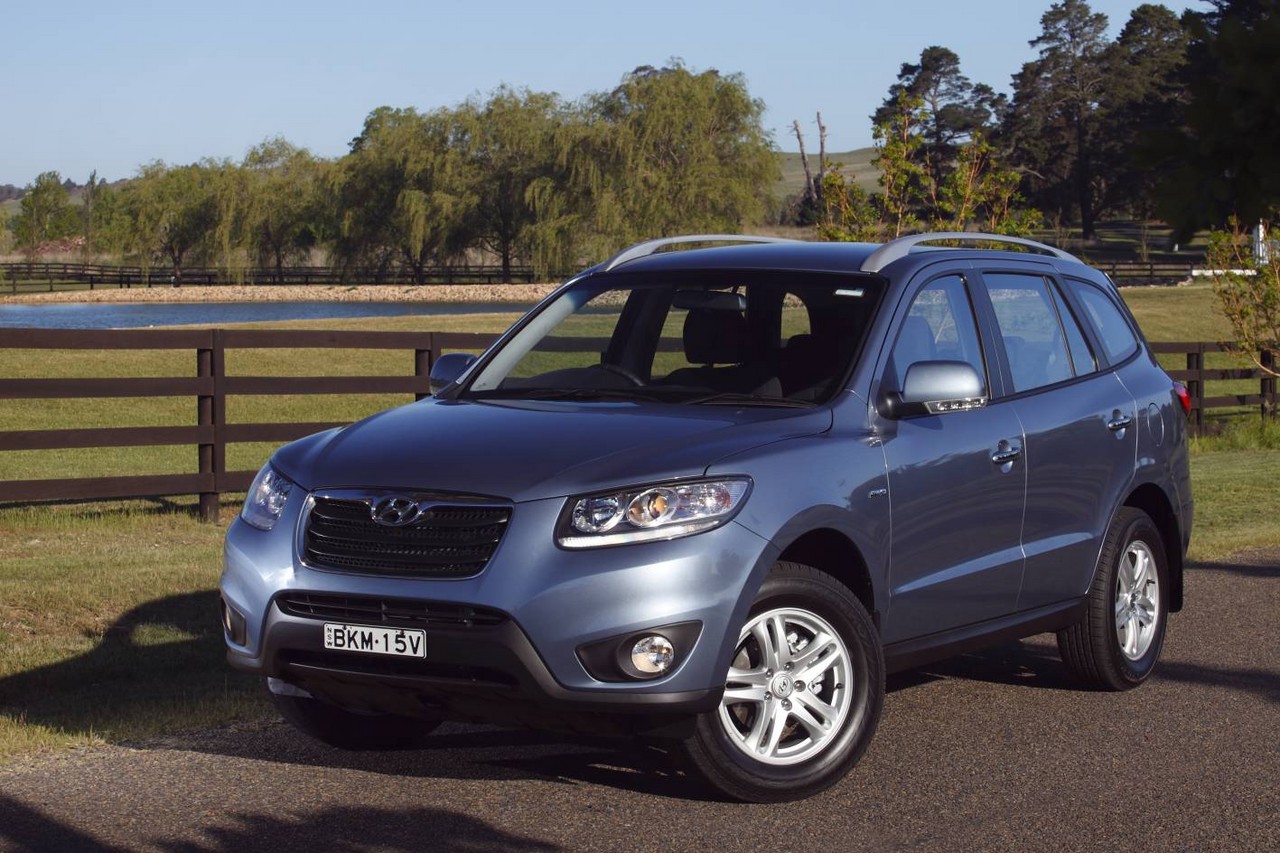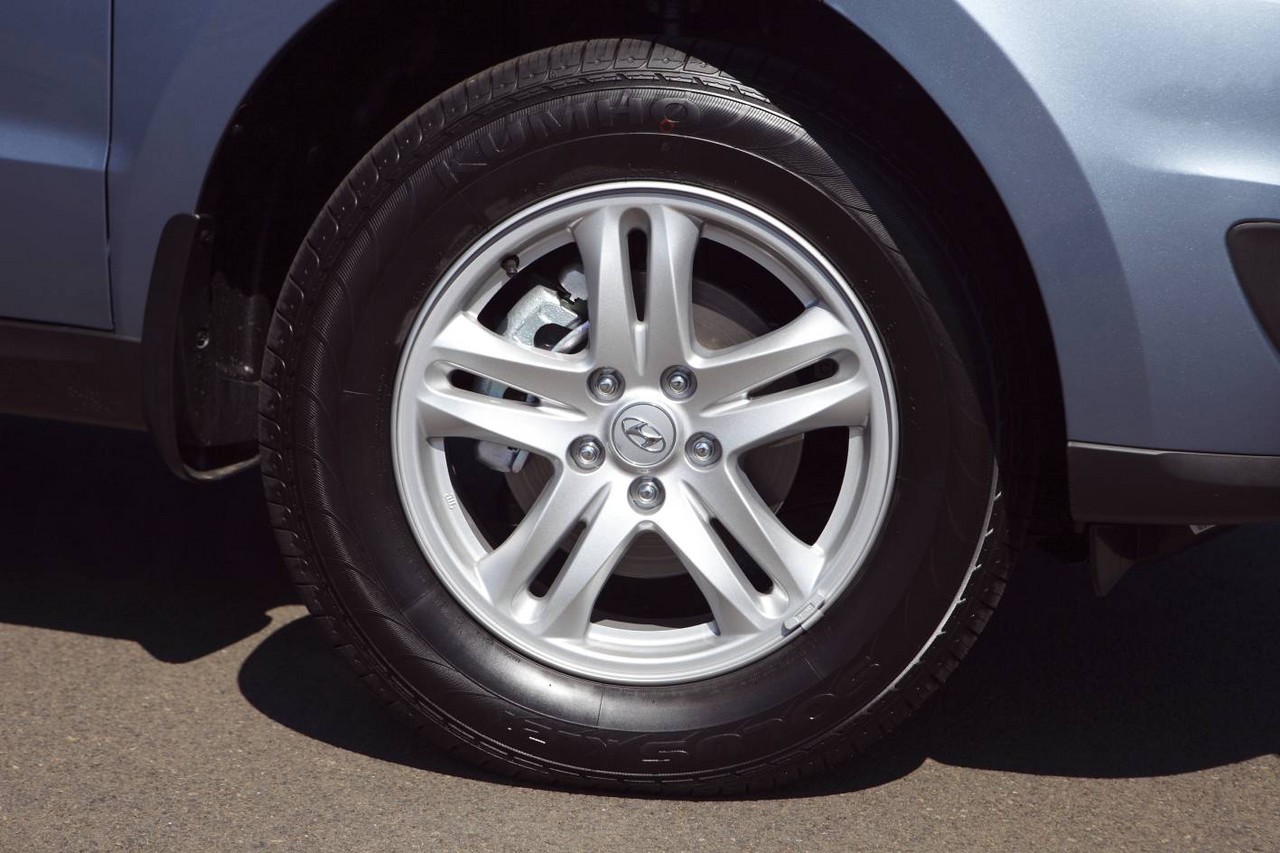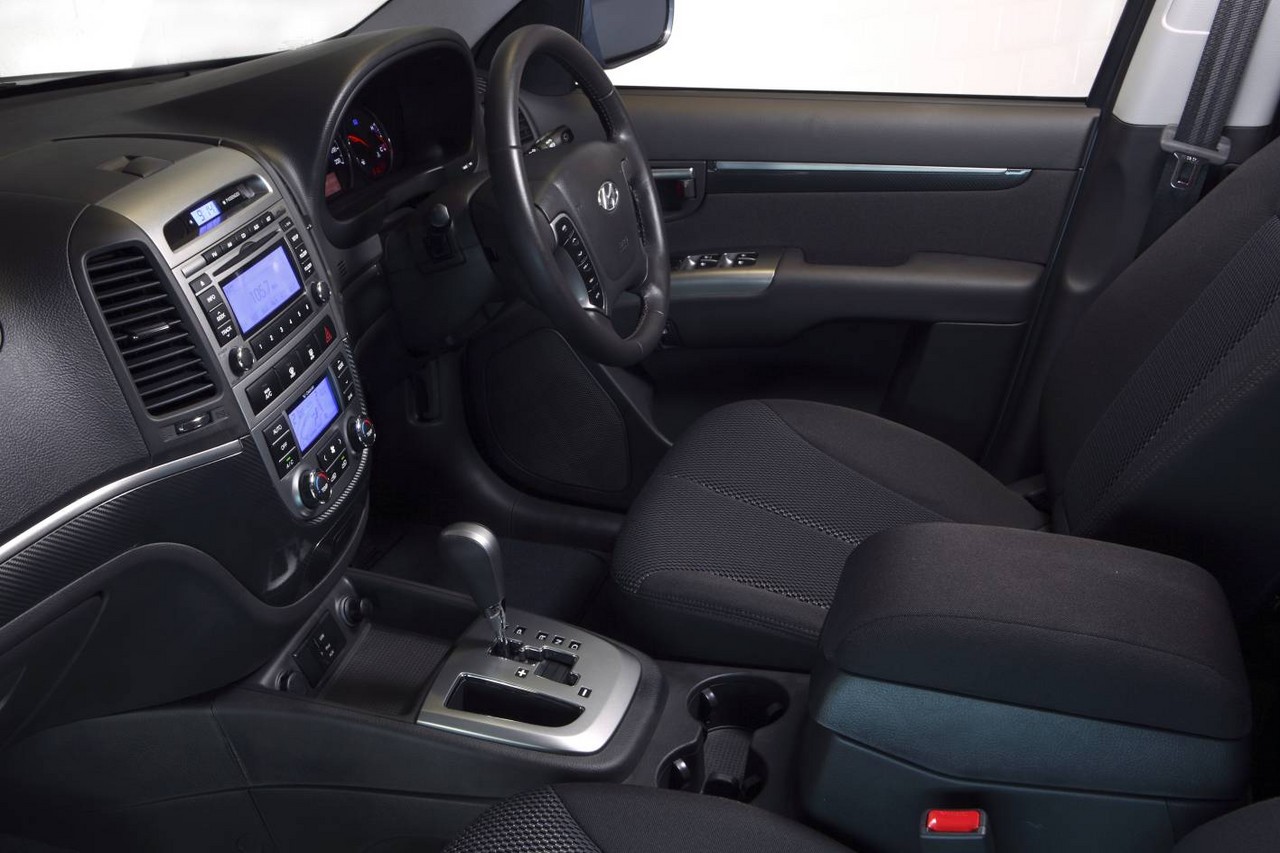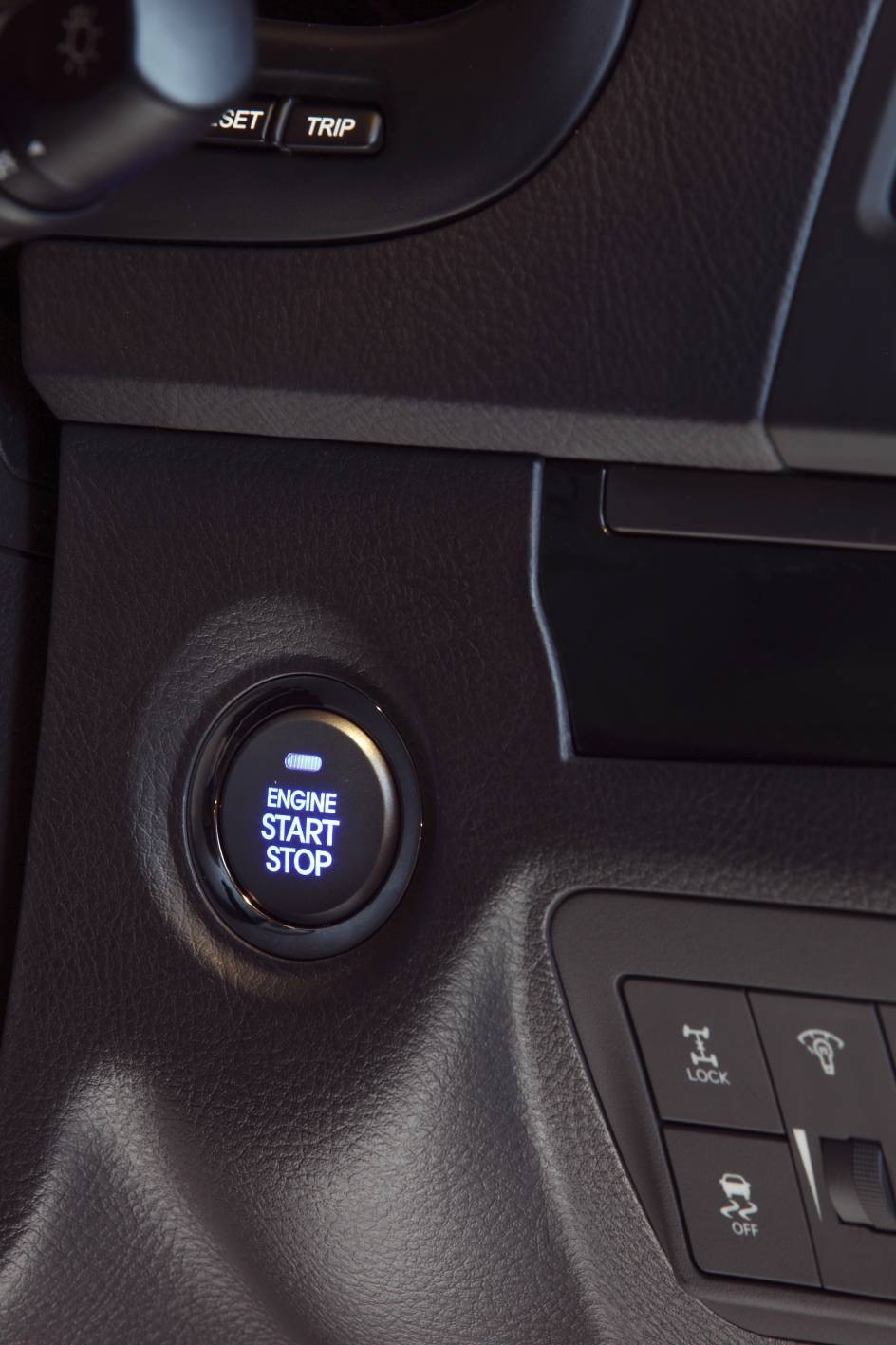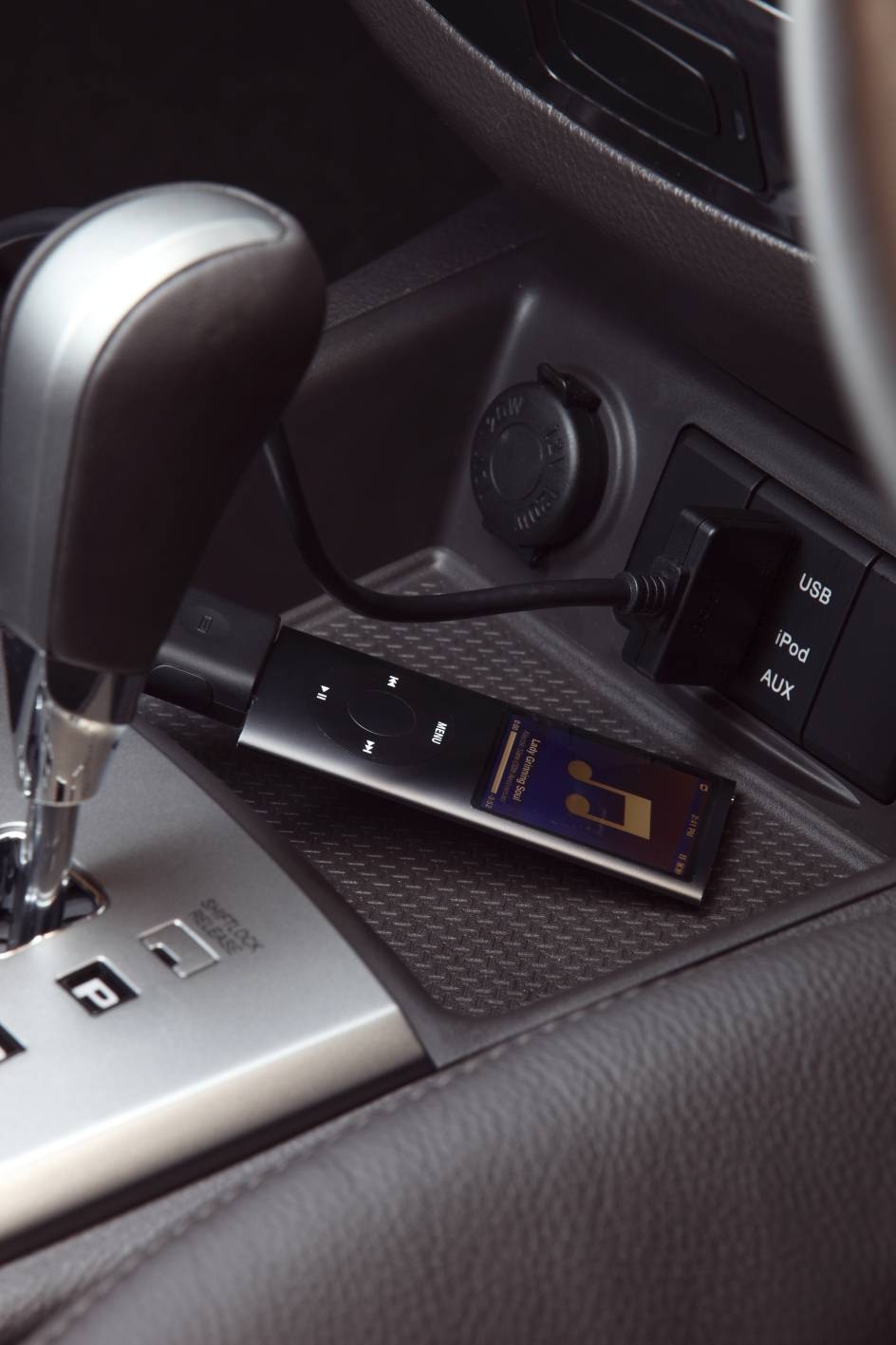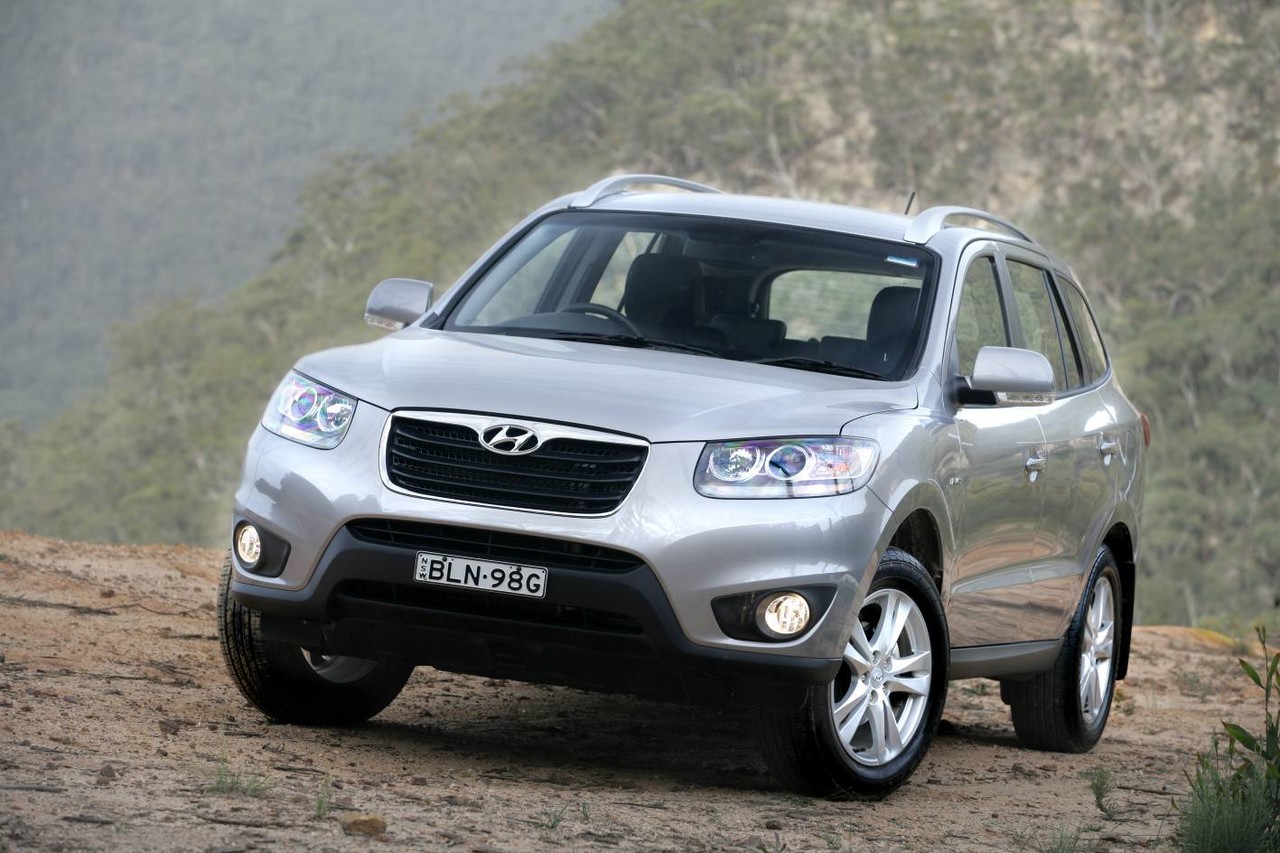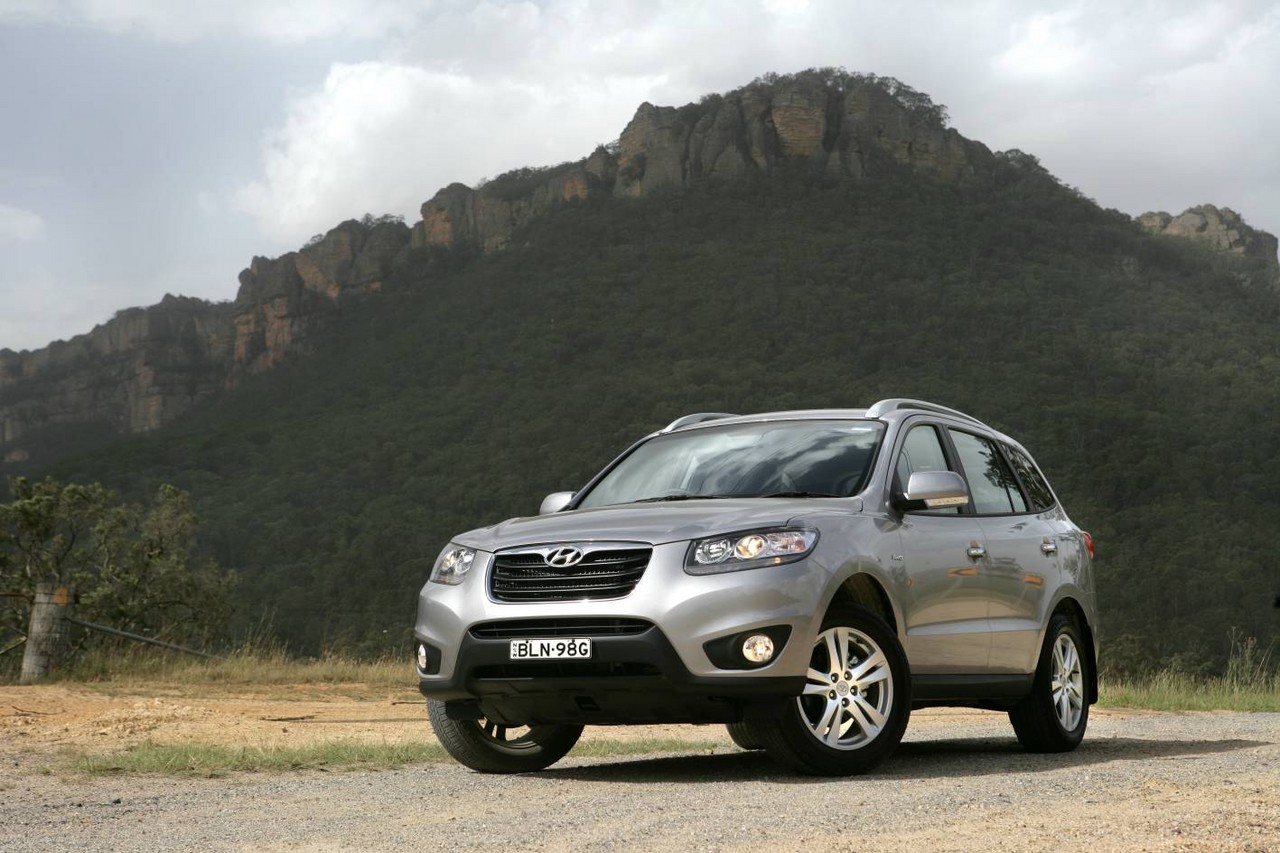
- Responsive 2.2-litre turbo-diesel engine
- Comfortable ride
- Quiet, well-insulated cabin
- Spacious interior
- 2.7-litre V6 petrol engine lacks low-rev torque
- Diesel engine noise at idle
- Outdated four-speed automatic transmissions
- Manual transmission has notchy action
- Awkward parking brake position
Review: Hyundai CM.I Santa Fe (2006-09)
Overview
Released in May 2006, the Hyundai CM Series I (CM.I) Santa Fe was a mid-size SUV, available with five or seven seats. Manufactured in Ulsan, South Korea, the CM Santa Fe was initially powered by 2.7-litre V6 petrol engines. In November 2006, however, the line-up was substantially revised with the introduction of the 2.2 CRDi and 3.3 V6 variants. The full range is given in the table below.
Engines; Mu, Lambda and Diesel
Of the engines,
- The 2.7-litre V6 ‘Mu’ engine had an aluminium block and cylinder heads, double overhead camshafts, four valves per cylinder, continuously variable intake valve timing (CVVT), a variable intake system (VIS) and a compression ratio of 10.4:1;
- The 3.3-litre G6DB ‘Lambda’ V6 engine had similar properties to the Mu engine (including compression ratio of 10.4:1); and,
- The 2.2-litre D4EB-G ‘D’ diesel engine had a cast iron block, aluminium alloy cylinder head, common-rail direct injection (operating at 1600 bar), a variable geometry Garrett GTB1549V turbocharger, a single overhead camshaft, four valves per cylinder and a compression ratio of 17.3:1.
Dimensions and body
Compared to the SM Santa Fe , the CM Santa Fe was 175 mm longer (at 4675 mm), 45 mm wider (1890 mm), 65 mm taller (1795 mm) and had an 80 mm longer wheelbase (2700 mm). The CM Santa Fe chassis achieved a 50 per cent increase in bending rigidity, in part due to the use of a heavily ribbed floor pan pressing, tubular cross-bracing within the firewall, central vertical bracing, reinforced windscreen pillars, side sills and side-impact door beams.
Suspension
The CM Santa Fe had MacPherson strut front suspension and upper wishbone, multi-link rear suspension (both with coil springs, gas-filled dampers and anti-roll bars).
| Variant | Edition | Years | Seats | Trans. | Peak power | Peak torque |
|---|---|---|---|---|---|---|
| 2.7 V6 (AWD) | [Unnamed] | 2006 | 5 or 7 | 4sp auto, 5sp man | 138 kW at 6000 rpm | 248 Nm at 4000 rpm |
| SX | 2007-09 | 5 | ||||
| SLX | 2006-07 | 5 or 7 | ||||
| Elite | 2006-07 | 5 | 4sp auto | |||
| 2.2 CRDi (AWD) | SX | 2006-09 | 5 | 5sp auto, 5sp man | 114 kW at 4000 rpm | 343 Nm at 1800-2500 rpm |
| SLX | 2006-09 | 7 | 5sp auto | |||
| Elite | 2006-09 | 5 | ||||
| 2007-09 | 7 | |||||
| 3.3 V6 (FWD) | SX | 2007-08 | 5 | 5sp auto | 180 kW at 6000 rpm | 309 Nm at 4000 rpm |
| SLX | 2007-08 | 5 or 7 | ||||
| Elite | 2007-08 | 7 |
AWD system
The Santa Fe 2.2 CRDi and 2.7 V6 variants had a Borg-Warner Torque Management all-wheel-drive system. In normal conditions, the engine’s torque was primarily directed to the front wheels. In the event that traction was lost, however, up to 50 per cent of the engine’s torque could be redirected to the rear axle.
The driver could also select a ‘4WD Lock’ mode which provided a fixed 50:50 front:rear torque split for speeds of up to 30 km/h.
Safety equipment
Initially, standard safety equipment for the Santa Fe included dual front airbags, front seat-mounted side (thorax) airbags, full-length curtain airbags (i.e. for all rows of seats), ABS, electronic brake force distribution, electronic stability control, traction control, active front seat head restraints, anti-submarining front seat steel pans and front seatbelts with pretensioners and load limiters.
From November 2006, the newly introduced Santa Fe SX omitted front side (thorax) airbags, curtain airbags, electronic stability control and traction control, with these features reserved for the SLX and Elite editions. From July 2008, however, the Santa Fe SX was fitted with the same safety equipment as the SLX and Elite (i.e. front side (thorax) airbags, front and rear curtain airbags, electronic stability control and traction control).
Euro NCAP crash testing
In Euro NCAP crash testing , a left-hand drive CM.I Santa Fe 2.2 CRDi with dual front airbags, front side airbags and curtain airbags achieved a four star adult occupant protection rating with a score of 29.34 out of 37. In the frontal offset crash test, protection from serious leg injury was marginal for the driver.
Features: Santa Fe, SX, SLX and Elite
Standard features for the Santa Fe and Santa Fe SX editions included 17-inch alloy wheels, six speaker sound system with CD player and MP3/WMA compatibility, air conditioning, cruise control, front fog lights (entry-level V6 only), rear fog lights, 60/40 split and folding second row seats, a leather-wrapped steering wheel, remote central locking, power windows and mirrors, a tilt and reach adjustable steering wheel, a height adjustable driver’s seat, a cargo blind and net, roof racks and rails, 12 volt power outlets, a trip computer, an alarm and immobiliser.
Beyond this, the Santa Fe SLX added front fog lights, mesh-weave seat fabrics, a centre console cool box and heated door mirrors; where fitted with seven seats, the third row seats featured rear air conditioning controls and could be folded flat into the floor. From July 2008, the SLX was also fitted with dual-zone climate control air conditioning.
The Santa Fe Elite was distinguished by its 18-inch six-blade alloy wheels with 235/60 tyres, seven speaker sound system with six-disc CD player, dual-zone climate control air conditioning, leather seat facings and trim, ten-way power adjustable driver’s seat, four-way power adjustable front passenger seat, automatic headlights, electrochromatic rear view mirror, power tilt/slide sunroof and rear roof spoiler.
Review: Hyundai CM.II Santa Fe (2009-12)
Overview
Released in December 2009, the CM Series II (CM.II) Santa Fe introduced a simplified range, improved occupant safety and a subtle facelift. Initially, the CM.II Santa Fe was only available with a 2.2-litre four-cylinder turbo-diesel engine (‘2.2 CRDi’), but 3.5-litre petrol V6 models (‘3.5 V6’) were introduced in May 2011. While the 2.2 CRDi variants were fitted with all-wheel drive, the 3.5 V6 variants were strictly front-wheel drive. All variants, however, were fitted with seven seats and available in SLX, Elite and Highlander editions.
Visually, the CM.II Santa Fe could be identified by its body-coloured grille with horizontal bars, new head- and tail-lights, bumpers, front fog lights, new wing mirrors with integrated indicators, tailgate spoiler, roof rails and alloy wheel designs.
D4HB and G6DC engines
Of these engines,
- the 2.2-litre D4HB ‘R’ diesel engine had an aluminium engine block and cylinder head, common-rail direct injection with piezo injectors (operating at 1800 bar), a variable geometry Garrett GTB1752VLK turbocharger, double overhead camshafts, four valves per cylinder and a compression ratio of 16.0:1; and,
- compared to its 3.3-litre predecessor, the 3.5-litre G6DC ‘Lambda II’ V6 petrol engine was distinguished by its variable intake and exhaust valve timing (D-CVVT), extended variable intake system and higher compression ratio (10.6:1 compared to 10.4:1).
| Variant | Years | Engine | Edition | Trans. | Peak power | Peak torque |
|---|---|---|---|---|---|---|
| 2.2 CRDi | 2009-12 | 2.2-litre turbo-diesel I4 | SLX | 6sp man. | 145 kW at 3800 rpm | 421 Nm at 1800 rpm |
| SLX, Elite, Highlander |
6sp auto | 145 kW at 3800 rpm | 436 Nm at 1800-2500 rpm | |||
| 3.5 V6 | 2011-12 | 3.5-litre petrol V6 | SLX, Elite, Highlander |
6sp auto | 204 kW at 6300 rpm | 335 Nm at 5000 rpm |
Safety equipment
Standard safety equipment for the CM.II Santa Fe included dual front airbags, front side airbags, full length curtain airbags, ABS, electronic brake force distribution, electronic stability control, traction control, active front seat head restraints, rollover sensors and front seatbelts with pretensioners and load limiters.
ANCAP safety assessment
Based upon improvements to its predecessor, ANCAP awarded the CM.II Santa Fe a five star adult occupant protection rating due to improved upper leg protection in the frontal offset crash test, an additional point for the pole test and two additional points for the front seatbelt reminders – this resulted in an adult occupant protection score of 33.34 out of 37.
Features
Standard features for the Santa Fe SLX included 17-inch alloy wheels, a six speaker sound system with CD player, auxiliary inputs and iPod/USB connectivity, air conditioning, cruise control, front fog lights, rear parking sensors, steering wheel audio controls, remote central locking, power windows and heated mirrors, a tilt and reach adjustable steering wheel, rear map lights, cargo net and an immobiliser.
Beyond this, the Santa Fe Elite added dual-zone climate control air conditioning with third row vents, a power adjustable driver’s seat, cooled centre compartment, automatic headlights, leather-wrapped steering wheel, roof rails and chrome door handles.
Finally, the range-topping Santa Fe Highlander was further equipped with 18-inch alloy wheels, a seven speaker sound system with six-stack CD player, leather seats, power adjustable front seats, reversing camera, rain-sensing wipers, power glass sunroof, an electrochromatic rear view mirror, power folding mirrors and stainless steel scuff plates.
November 2011: Santa Fe update
In November 2011, the CM.II Santa Fe underwent a minor update as hill descent control was fitted to all models with automatic transmissions. Furthermore, cosmetic updates included restyled front and rear silver-finish skid plates, chrome tailgate garnish, black roof rails (previously silver) and high-gloss black finish for the fog lights on Elite and Highlander editions. The Highlander was also fitted with redesigned 18-inch alloy wheels and, inside, featured black perforated leather seats.
2012 Santa Fe Trail edition
In April 2012, a limited-run 2.2 CRDi Trail edition was released. Compared to the SLX, the Trail was further equipped with 18-inch alloy wheels, leather/leatherette seat trim, a leather-wrapped steering wheel and gearshift knob, a reversing camera with an electrochromatic display within the rear-view mirror, a rear seat entertainment system with a CD/DVD player, headphones and remote control and rear privacy glass. Visually, the Trail editions could be identified by their chrome tailgate garnish and ‘Trail’ badge on the rear tailgate.
Brochures
Related links
- Press release: Hyundai CM.II Santa Fe (October 2009)
- Press release: Hyundai CM.II Santa Fe update (November 2011)
- Specifications: Hyundai CM.II Santa Fe (November 2011)
- Press release: Hyundai CM.II Santa Fe Trail (April 2012)
- Wikipedia.org: Hyundai CM Santa Fe
